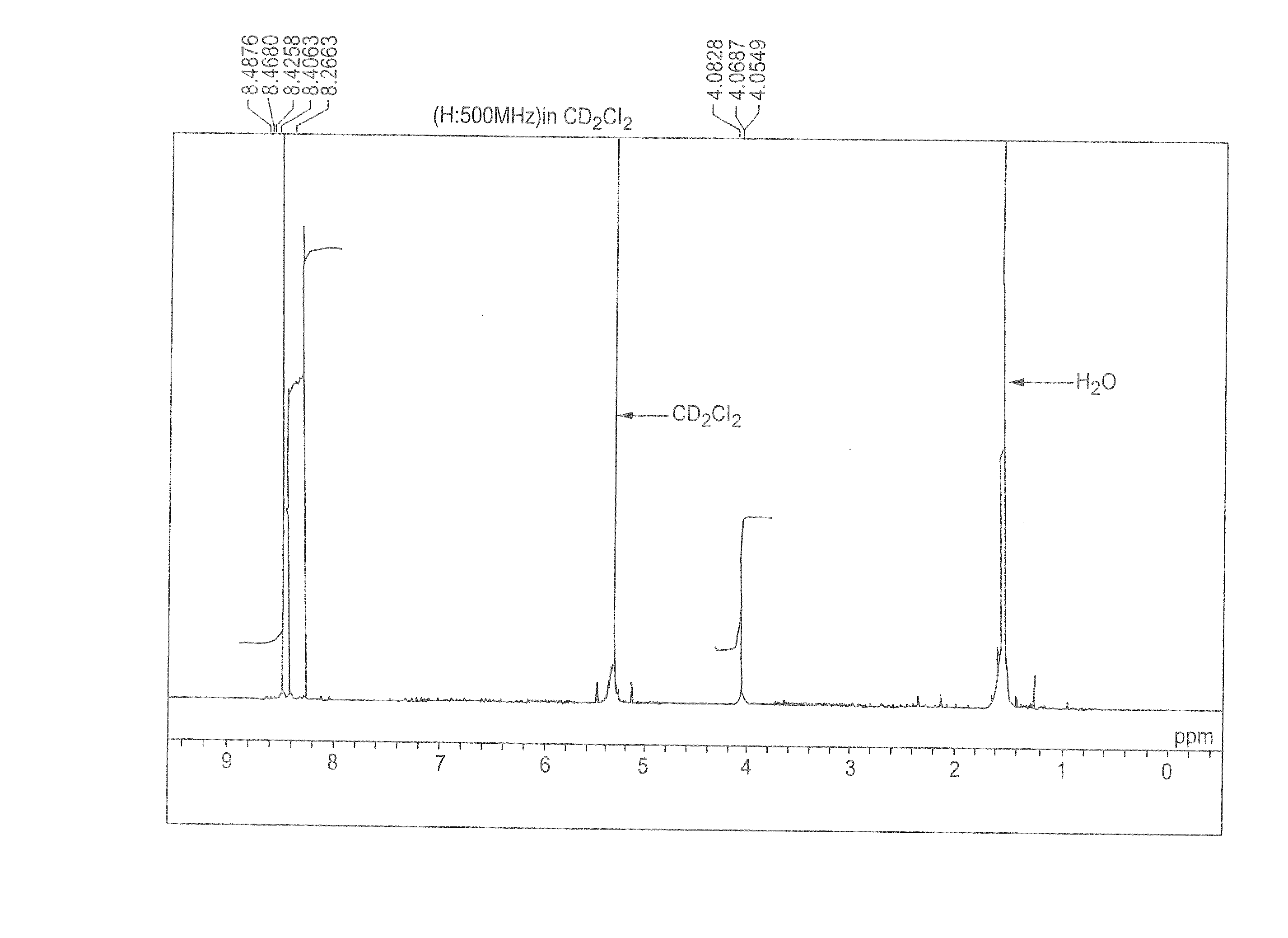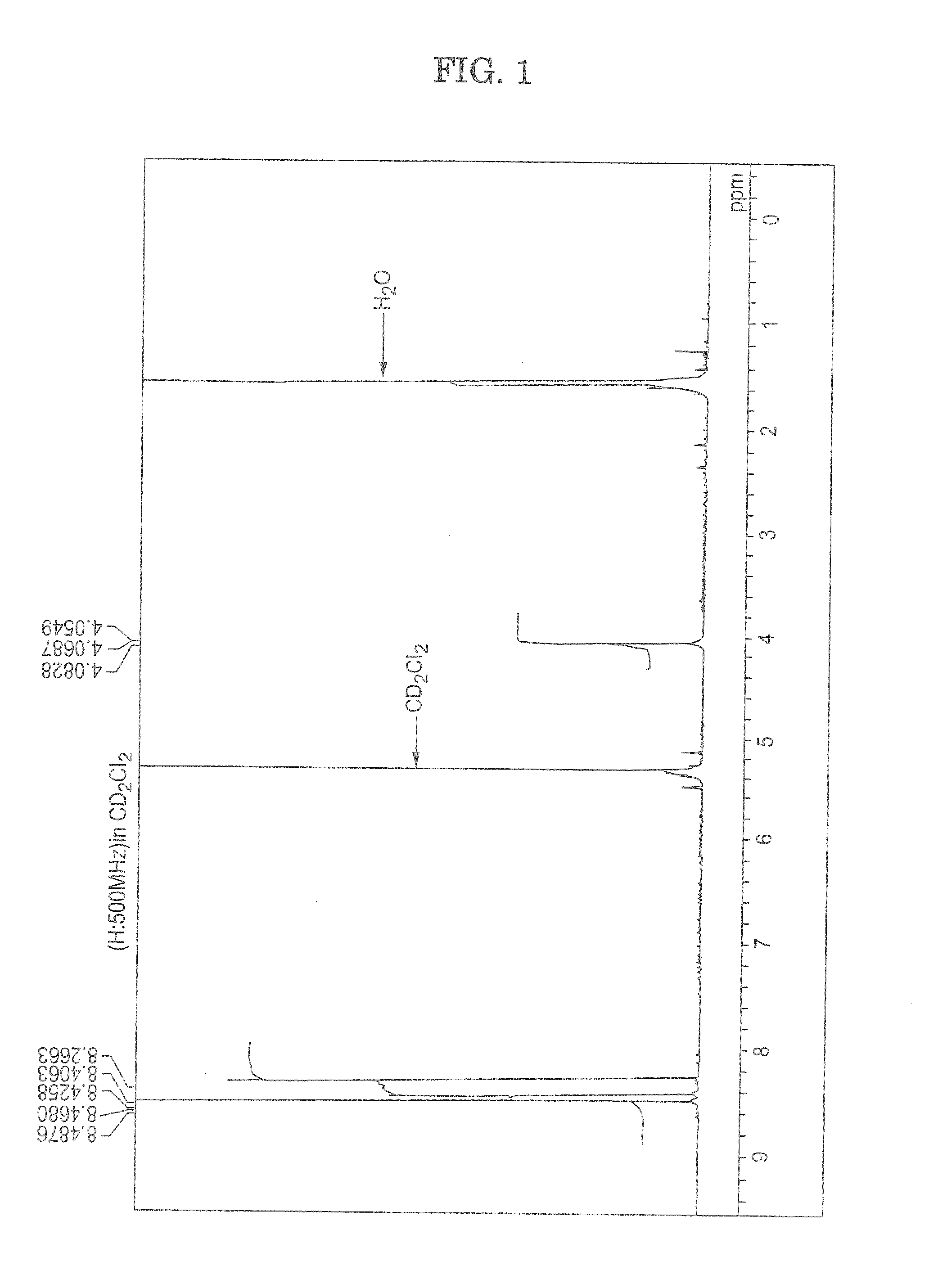1,6-Substituted 3,8-Dihalogenopyrene And Process For Producing The Same
a technology of dihalogenopyrene and pyrene, which is applied in the field of producing the 1,6-substituted 3,8-dihalogenopyrene and the process of producing the same, can solve the problem of not being able to easily improve the purity of the (1,8) articl
- Summary
- Abstract
- Description
- Claims
- Application Information
AI Technical Summary
Benefits of technology
Problems solved by technology
Method used
Image
Examples
example 1
Synthesis of (1,6-diisopropyl-3,8-dibromopyrene)
[0051] Under an atmospheric argon gas flow, 1,6-dibromopyrene in an amount of 20 g (55.6 millimole), isopropylmagnesiumbromide in an amount of 117 milliliter [117 millimole, 1 mole / litter (THF: tetrahydrofuran)], (diphenylphosphinoferrocene)palladium(II)dichloride in an amount of 2.27 g (5% by mole) and dried dioxane in an amount of 130 milliliter were placed into a three-neck flask equipped with a cooling pipe and having a capacity of 500 milliliter, and the resultant solution was stirred with heating at a temperature of 90° C. for 8 hours.
[0052] After the completion of the reaction, adding 100 milliliter of dilute hydrochloric acid, an organic layer was separated and concentrated under a reduced pressure. Then, the organic layer was passed through a silicagel short column, and after concentrating under the reduced pressure again, a precipitated crystal was separated by filtration and as a result, 7.4 g of 1,6-diisopropyl pyrene (pa...
example 2
Synthesis of (1,6-dicyclohexyl-3,8-dibromopyrene)
[0056] Under an atmospheric argon gas flow, 1,6-dibromopyrene in an amount of 20 g (55.6 millimole), cyclohexylmagnesiumbromide in an amount of 117 milliliter (117 millimole, 1 mole / litter (THF)), (diphenylphosphinoferrocene)palladium(II)dichloride in an amount of 2.27 g (5% by mole) and dried dioxane in an amount of 80 milliliter were placed into a three-neck flask equipped with a cooling pipe and having a capacity of 500 milliliter, and the resultant solution was stirred with heating at a temperature of 90° C. for 8 hours.
[0057] After the completion of the reaction, adding 100 milliliter of dilute hydrochloric acid, an organic layer was separated and concentrated under a reduced pressure. Then, the organic layer was passed through a silicagel short column, and after concentrating under the reduced pressure again, a precipitated crystal was separated by filtration and as a result, 7.0 g of 1,6-dicyclohexylpyrene (pale yellow powder...
example 3
Synthesis of 1,6-di(2-naphthyl)-3,8-dibromopyrene]
[0061] Under an atmospheric argon gas flow, 1,6-dibromopyrene in an amount of 10.3 g (28.6 millimole), 2-naphthylboronic acid in an amount of 11.8 g (68.7 millimole), tetrakis(triphenylphosphine)palladium(0) in an amount of 0.66 g (2% by mole), sodium carbonate aqueous solution in an amount of 43 milliliter (59.4 millimole, 2M), dimethoxyethane (DME) in an amount of 100 milliliter and dried THF in an amount of 70 milliliter were placed into a three-neck flask equipped with a cooling pipe and having a capacity of 200 milliliter, and the resultant solution was stirred with heating at a temperature of 90° C. for 8 hours.
[0062] After the completion of the reaction, adding 50 milliliter of water, precipitated crystal was separated by filtration and washed with the use of 50 milliliter of water and 100 milliliter of ethanol, and as a result. 13.2 g of pale yellow powder was obtained (the yield: 99%).
[0063] Subsequently, under an atmosphe...
PUM
| Property | Measurement | Unit |
|---|---|---|
| temperature | aaaaa | aaaaa |
| temperature | aaaaa | aaaaa |
| temperature | aaaaa | aaaaa |
Abstract
Description
Claims
Application Information
 Login to View More
Login to View More - R&D
- Intellectual Property
- Life Sciences
- Materials
- Tech Scout
- Unparalleled Data Quality
- Higher Quality Content
- 60% Fewer Hallucinations
Browse by: Latest US Patents, China's latest patents, Technical Efficacy Thesaurus, Application Domain, Technology Topic, Popular Technical Reports.
© 2025 PatSnap. All rights reserved.Legal|Privacy policy|Modern Slavery Act Transparency Statement|Sitemap|About US| Contact US: help@patsnap.com



